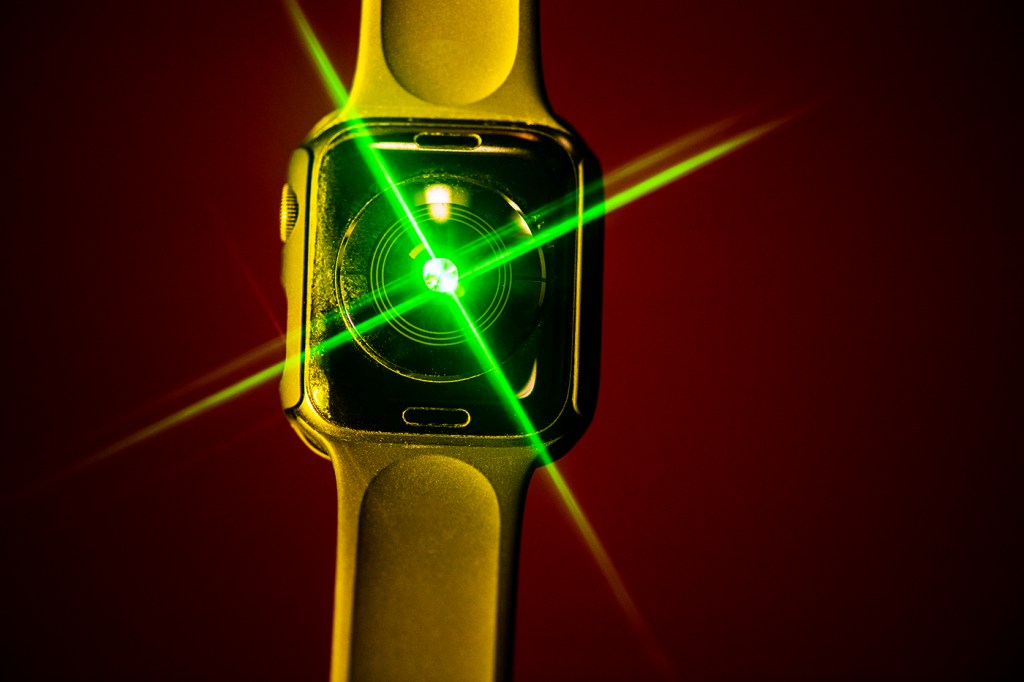Ditch the bulky fitness tracker. Wearable tech is getting an upgrade.

Wearable technology is everywhere. If you look around your office or classroom, family gathering or workout class, someone is probably wearing a smartwatch, a fitness tracker, or some other electronic device that can detect, monitor, and analyze signals from their body.
Activity trackers are particularly popular, and “wearables” also can be important tools for monitoring someone’s health, tracking metrics such as heart rate and blood oxygen level.
But they face a limitation. Most wearables are made of sensors embedded into hard plastic.
“It’s rigid, it’s uncomfortable. Nobody wants to walk around with rigid things attached to their body, right?” says Canek Fuentes-Hernandez, an associate professor of electrical and computer engineering at Northeastern. “It’s not very wearable.”

Canek Fuentes-Hernandez, associate professor of electrical and computer engineering at Northeastern. Photo by Alyssa Stone/Northeastern University
That stiffness has been a limitation on how wearables could be deployed, Fuentes-Hernandez says. But he may have created a solution: A soft material that can stretch and flex like (and with) a user’s skin.
“Materials like the one that we developed could potentially lead to sensors that could just be attached to the skin, and the wearer of these sensors wouldn’t even notice their presence, because they just behave like the skin,” Fuentes-Hernandez says.
Not only could this second-skin-like material offer more comfort to a user, it also could help solve another problem with wearables: power. Devices that are constantly monitoring bodily functions can drain power quickly, Fuentes-Hernandez says. And, if their purpose is to continually monitor something, a device that needs to be taken off and charged frequently is less useful.
One way that wearables measure signals from the body is by using light. Such devices are called photodetectors. The stretchable material Fuentes-Hernandez and his colleagues developed enabled a highly sensitive photodetector that could reduce the power consumption of this process.
The trick, Fuentes-Hernandez says, is “patterning the photodetector as a ring with a light source in the middle. As we and others have demonstrated, this shape allows you to capture the signal with less light, and consequently using less electrical power, than what is currently used in commercial devices.”
“If we can reduce the power consumed by an order of magnitude, now rather than being able to wear this for a few hours, that means I can wear this for several days,” he says. “And that has tremendous consequences on our ability to monitor continuously some biometric signals that are of importance.”
Take a pulse oximeter, for example. That is the small plastic device that your doctor clips onto a fingertip to measure the oxygen saturation of blood. It yields critical data about how well lungs are functioning, and about heart health. A pulse oximeter made for continuous daily use could help doctors catch and treat severe heart problems faster.
This project was done by Fuentes-Hernandez and colleagues at Georgia Institute of Technology, where he was a principal research scientist at the Center for Organic Photonics and Electronics and the School of Electrical and Computer Engineering before joining Northeastern in August 2021. The material is described in a paper published last month in the journal Science Advances. Fuentes-Hernandez plans to continue developing soft and stretchable semiconductors and devices in his laboratory at Northeastern.
He plans to focus first on the medical applications of this material. He aims to demonstrate how this material can be used to develop soft, stretchable, ergonomic pulse oximeters.
But the applications could go beyond the medical realm, he says. “The fact that you have something that can deform its shape without breaking, that can have a lot of implications regarding where you can deploy sensors,” he says. “I’m interested in deploying sensors, for instance, for smart agriculture.”
A material that can move with human skin also could potentially move with a growing plant or fruit, he says. A sensor that could grow with the fruit could monitor its color or other indicators to know when it’s ripe, for example.
“It’s a technology that can sit at the surface of a biological entity,” Fuentes-Hernandez says, and that could open up a world of possibilities.
For media inquiries, please contact Ed Gavaghan at e.gavaghan@northeastern.edu or 617-373-5718.





